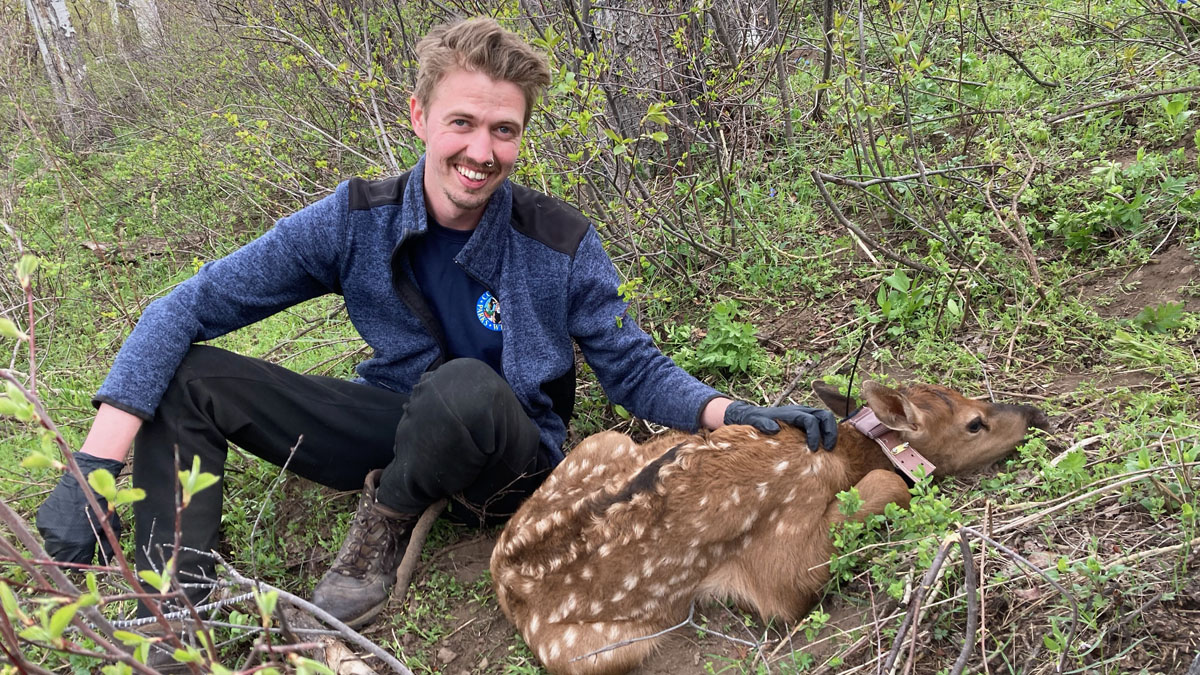
Storm Crews, a graduate student in zoology at Southern Illinois University Carbondale, sits with a young elk in the Colorado mountains this summer. Working with Guillaume Bastille-Rousseau, assistant professor at SIU’s Cooperative Wildlife Research Laboratory, and Colorado wildlife officials, Crews has spent about a year mapping the migration routes Colorado elk use as they manage their life cycle, wandering from one habitat to another. (Photo provided)
August 04, 2021
Mapping their future: SIU graduate student is researching Colorado elk migratory routes
CARBONDALE, Ill. — When you think about the mighty elk, a majestic mainstay of the American West, words like “fragile” probably don’t come immediately to mind. But a student researcher from Southern Illinois University Carbondale knows protecting their habitat and migration routes is key to sustaining the comeback they’ve made in places like Colorado, home to the largest of their number in the country.
Storm Crews, a graduate student in zoology at SIU, has spent about a year studying and mapping the impressive migration routes that Colorado elk use as they manage their life cycle, wandering from one habitat to another. Working with Guillaume Bastille-Rousseau, assistant professor at SIU’s Cooperative Wildlife Research Laboratory and Nathaniel Rayl at Colorado Parks and Wildlife, Crews hopes that mapping the animals’ migratory routes, characterizing their seasonal home ranges, and studying the factors that trigger migrations will lead to better informed management strategies, helping keep the important species healthy and vibrant for generations to come.
“Elk are among the most charismatic ungulates remaining on the North American continent, and often exhibit impressive displays of migration spanning great distances,” said Crews, a native of High Point, North Carolina. “They play a sizeable role in recreational hunting and tourism economies, livestock and wildlife disease dynamics, biogeochemical cycling and important predator-prey interactions.”
Crunching data, seeing patterns
Last August, Crews began crunching geographic information systems data that Colorado Parks and Wildlife researchers had collected since 2017. The state agency is helping fund the research, along with SIU. The data detailed hundreds of individual elk in four herds, strewn throughout the state over a multi-year period.
To collect the data, elk from the four herds were fitted with GPS collars, which can show exactly via satellites where a given animal is at regular two-hour intervals.
“We can use this location information in conjunction with GIS layers and statistical models to conduct all sorts of analyses,” Crews said. “We can investigate resource use and habitat preferences, map movement trajectories to identify migratory routes and periods, quantify home range sizes, and much more.”
Should they stay or go?
One key question he is examining is what prompts elk to migrate to a new area, or choose to stay put year-round while some of the herd move. Given this partially migratory characteristic, Crews is interested in the strategy individual elk seem to follow, and how resource use might differ among elk who seasonally migrate versus those that stay in the same area year-round.
To that end, he spends time writing complex computer programs that help analyze the complicated data and classify the movement strategies of each individual elk.
“Making sense of this has important conservation implications, and can help to inform herd-specific management goals,” Crews said. “I’ve also spent time looking into identifying spatial intersections between migration routes and transportation infrastructure, such as highways, in order to assess potential threats to connectivity in this system.”
Getting into the field
While much of his work involves computer analysis, Crews did enjoy one season with the elk in the field, working on a different, but closely related study. This summer saw him capturing and fitting collars onto young elk, and interacting with the animals and their environment in northwestern Colorado on a daily basis.
“Getting to spend time in these incredible landscapes with my study species was an invaluable experience,” Crews said. “It will surely inform my work on the project moving forward.”
He hopes to finish his work by the middle of 2022.
Surprising findings so far
The sheer scale of the elk migrations boggles the mind a bit, Crews said. They may wander more than 60 miles to get from one seasonal range to another, according to the data, and much of that distance involves challenging terrain. Many of the elk he is studying regularly venture from a low elevation winter range to a high elevation summer range, with thousands of feet in elevation change not being uncommon between ranges, Crews said.
“As one who has just spent a summer constantly out of breath in these mountains, I can’t help but be impressed,” Crews said. “Elk are very well adapted to their environment, and it surely speaks to the fitness benefits of having separate seasonal ranges that they would expend so much energy and effort to engage in this behavior.”
A fragile balance
Yet even with the raw strength and stamina the animal exhibits, Crews said the current abundance of elk in Colorado didn’t happen by accident. Pressure from humans and unregulated hunting many years ago pushed these native herds to near non-existence.
“Rocky Mountain Elk in Colorado actually represent a conservation success story,” Crews said. Only reintroduction and careful management practices brought them back to their current healthy numbers. SIU’s work is part of this ongoing effort, and Crews said he is honored to be part of it.
“It is important that we do not take these majestic animals for granted,” Crews said. “With ever-expanding urban development and climate change among present and future threats to these populations, conservation strategies informed by research are key to ensuring that elk can endure and remain one of the natural prides of the American West.”
